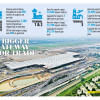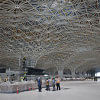Shaping Bangladesh’s future as an aviation hub

The adage 'first impressions are the last impressions, and often the most enduring' rings true, particularly in the context of cities and countries, where airports play a pivotal role in shaping these impressions.
Dhaka's old-fashioned Hazrat Shahjalal International Airport (HSIA), built in 1980, has not undergone any major renovations since then. Furthermore, the main gateway to the country by air does not align with the present state of the capital, especially as Bangladesh is advancing towards becoming a developing nation.
With this backdrop, the dream of constructing the iconic and spectacular third terminal at HSIA, which began in December 2019, has finally become a reality today. Prime Minister Sheikh Hasina will soft launch the third terminal amid celebrations.
"It's a dream come true. The eye-catching design and modern structure of the iconic terminal, along with world-class facilities, will redefine the passenger experience at Dhaka Airport," said Civil Aviation Authority of Bangladesh (CAAB) Chairman Air Vice Marshal M. Mafidur Rahman.
"With the usage of the third terminal, your journey will be a pleasant experience. The definition of people's airport experience will change with the full operation of this terminal," he added.
The CAAB chief explained that the third terminal is being built in a way that allows passengers to get a good idea of Bangladesh upon landing at the airport. All kinds of facilities will be available in this terminal.
Approximately 90 percent of the terminal's construction work is completed, with ongoing work on interior decoration and the installation of various types of equipment.
Bangladesh's prospects of becoming a regional aviation hub will brighten with the full operation of the third terminal, as many foreign carriers have already expressed interest in operating flights to and from Dhaka, which will also contribute to the country's economic growth.
The third terminal will remain connected to the airport route of the MRT Line-1 project, according to MA Malek, chief engineer of the CAAB. Therefore, anyone arriving at Kamlapur Rail Station from any part of the country will be able to reach the third terminal via the underground metro rail, which spans 19.87 kilometers from Kamlapur to the Airport and includes 12 stations.
The third terminal will also be connected to the Airport Railway Station, allowing travelers to access the terminal via an underground path between the Airport Rail Station and the third terminal, as explained by an official of the third terminal project.
Moreover, pilgrims will have the option to access the terminal through an underground tunnel connected to the Ashkona Hajj Camp. Additionally, an elevated expressway will provide convenient access to the terminal.
Inbound passengers arriving from different countries, like outbound travelers, will be able to exit the airport without any hassle or inconvenience.
Despite its soft opening, air travelers will have to wait until the end of next year to fully utilize the terminal's services. This is due to the necessary calibration and preparation of the equipment used in terminal operations, as clarified by the CAAB boss. However, airlines will be able to use the new parking apron and taxiway of this terminal.
With its existing two terminals, HSIA is already operating at full capacity, handling eight million passengers annually. Anticipating passenger numbers to reach 14 million by 2025 and 24.8 million by 2035, the urgent need for the construction of a world-class terminal became evident.
In parallel with the third terminal project, four additional works are underway, including the construction of two high-speed taxiways alongside the terminal, which will expedite aircraft runway clearance and reduce take-off wait times.
Currently, car parking is a major problem at this airport, but the new terminal will have a parking facility for around 1,230 cars.
The celebrated architect Rohani Baharin designed the third terminal, with construction undertaken by Mitsubishi and Fujita of Japan and Samsung of Korea.
Anticipating passenger numbers to reach 14 million by 2025 and 24.8 million by 2035, the urgent need for the construction of a world-class terminal became evident.

 For all latest news, follow The Daily Star's Google News channel.
For all latest news, follow The Daily Star's Google News channel. 







Comments